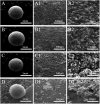Preparation of multigradient hydroxyapatite scaffolds and evaluation of their osteoinduction properties
- PMID: 35529045
- PMCID: PMC9071058
- DOI: 10.1093/rb/rbac001
Preparation of multigradient hydroxyapatite scaffolds and evaluation of their osteoinduction properties
Abstract
Porous hydroxyapatite (HA) scaffolds are often used as bone repair materials, owing to their good biocompatibility, osteoconductivity and low cost. Vascularization and osteoinductivity of porous HA scaffolds were limited in clinical application, and these disadvantages were need to be improved urgently. We used water-in-oil gelation and pore former methods to prepare HA spheres and a porous cylindrical HA container, respectively. The prepared HA spheres were filled in container to assemble into composite scaffold. By adjusting the solid content of the slurry (solid mixture of chitin sol and HA powder) and the sintering temperature, the porosity and crystallinity of the HA spheres could be significantly improved; and mineralization of the HA spheres significantly improved the biological activity of the composite scaffold. The multigradient (porosity, crystallinity and mineralization) scaffold (HA-700) filled with the mineralized HA spheres exhibited a lower compressive strength; however, in vivo results showed that their vascularization ability were higher than those of other groups, and their osteogenic Gini index (Go: an index of bone mass, and inversely proportional to bone mass) showed a continuous decrease with the implantation time. This study provides a new method to improve porous HA scaffolds and meet the demands of bone tissue engineering applications.
Keywords: biocompatibility; bone tissue engineering; osteoinduction; porous hydroxyapatite; scaffold.
© The Author(s) 2022. Published by Oxford University Press.
Figures












Similar articles
-
Preparation, in vitro degradability, cytotoxicity, and in vivo biocompatibility of porous hydroxyapatite whisker-reinforced poly(L-lactide) biocomposite scaffolds.J Biomater Sci Polym Ed. 2016;27(6):505-28. doi: 10.1080/09205063.2016.1140613. Epub 2016 Feb 12. J Biomater Sci Polym Ed. 2016. PMID: 26873015
-
Sr-HA scaffolds fabricated by SPS technology promote the repair of segmental bone defects.Tissue Cell. 2020 Oct;66:101386. doi: 10.1016/j.tice.2020.101386. Epub 2020 May 20. Tissue Cell. 2020. PMID: 32933709
-
A novel porous bioceramics scaffold by accumulating hydroxyapatite spherules for large bone tissue engineering in vivo. I. Preparation and characterization of scaffold.J Biomed Mater Res A. 2010 Jun 1;93(3):920-9. doi: 10.1002/jbm.a.32408. J Biomed Mater Res A. 2010. PMID: 19708076
-
Computer-aided design/computer-aided manufacturing of hydroxyapatite scaffolds for bone reconstruction in jawbone atrophy: a systematic review and case report.Maxillofac Plast Reconstr Surg. 2016 Jan 4;38(1):2. doi: 10.1186/s40902-015-0048-7. eCollection 2016 Dec. Maxillofac Plast Reconstr Surg. 2016. PMID: 26767187 Free PMC article. Review.
-
Frontiers of Hydroxyapatite Composites in Bionic Bone Tissue Engineering.Materials (Basel). 2022 Nov 28;15(23):8475. doi: 10.3390/ma15238475. Materials (Basel). 2022. PMID: 36499970 Free PMC article. Review.
Cited by
-
Morphologies, mechanical and in vitro behaviors of DLP-based 3D printed HA scaffolds with different structural configurations.RSC Adv. 2023 Jul 11;13(30):20830-20838. doi: 10.1039/d3ra03080f. eCollection 2023 Jul 7. RSC Adv. 2023. PMID: 37441027 Free PMC article.
-
Applications of Hydroxyapatite-Based Polymeric Scaffolds in Bone Tissue Engineering: An Update.Adv Pharm Bull. 2024 Dec 30;14(4):794-806. doi: 10.34172/apb.43818. Epub 2024 Oct 16. Adv Pharm Bull. 2024. PMID: 40190685 Free PMC article. Review.
-
Recent advancement in vascularized tissue-engineered bone based on materials design and modification.Mater Today Bio. 2023 Nov 11;23:100858. doi: 10.1016/j.mtbio.2023.100858. eCollection 2023 Dec. Mater Today Bio. 2023. PMID: 38024843 Free PMC article. Review.
-
3D-printed tri-element-doped hydroxyapatite/ polycaprolactone composite scaffolds with antibacterial potential for osteosarcoma therapy and bone regeneration.Bioact Mater. 2023 Aug 4;31:18-37. doi: 10.1016/j.bioactmat.2023.07.004. eCollection 2024 Jan. Bioact Mater. 2023. PMID: 37593495 Free PMC article.
-
Recent advances in regenerative biomaterials.Regen Biomater. 2022 Dec 5;9:rbac098. doi: 10.1093/rb/rbac098. eCollection 2022. Regen Biomater. 2022. PMID: 36518879 Free PMC article. Review.
References
-
- O’Neill E, Awale G, Daneshmandi L, Umerah O, Lo KW-H.. The roles of ions on bone regeneration. Drug Discov Today 2018;23:879–90. - PubMed
-
- Habraken W, Habibovic P, Epple M, Bohner M.. Calcium phosphates in biomedical applications: materials for the future? Mater Today 2016;19:69–87.
-
- Nair MB, Suresh Babu S, Varma HK, John A.. A triphasic ceramic-coated porous hydroxyapatite for tissue engineering application. Acta Biomater 2008;4:173–81. - PubMed
-
- Wang Q, Yan J, Yang J, Li B.. Nanomaterials promise better bone repair. Mater Today 2016;19:451–63.
LinkOut - more resources
Full Text Sources

